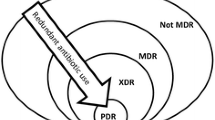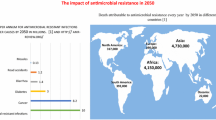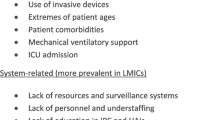Abstract
Purpose of Review
This review describes the multi-drug-resistant pathogens that lead to the most life-threatening infections, and the current state of prevention and management strategies used in clinical and emergency care.
Recent Findings
New methods of early detection and screening, novel combination antibiotics, and adjuvant therapy with a better understanding of the mechanisms employed by multi-drug-resistant bacteria are in the forefront of this impending public health crisis.
Summary
The incidence of infections caused by multi-drug-resistant pathogens is rising. A robust and concerted international response from the medical and public health communities is needed. The early identification of antibiotic-resistant pathogens and the appropriate targeted antibiotic therapy are the major determinants of decreased mortality. Antibiotic stewardship to slow the rate of antibiotic resistance and research and development of novel antibiotics must be encouraged and supported financially. Providers must also be vigilant with hand hygiene and environmental decontamination in all healthcare settings.
Similar content being viewed by others
References
Papers of particular interest, published recently, have been highlighted as: • Of importance •• Of major importance
U.S. Department of Health and Human Services: Centers for Disease Control and Prevention. Antibiotic resistant threats in the United States, 2013. Available at https://www.cdc.gov/drugresistance/pdf/ar-threats-2013-508.pdf.
O’Neill J. Tackling drug-resistant infections globally: final report and recommendations: the review on antimicrobial resistance; 2016. Available from:https:// amr-review.org.
Boucher HW, Talbot GH, Bradley JS, Edwards JE, Gilbert D, Rice LB, et al. Bad bugs, no drugs: no ESKAPE! An update from the Infectious Diseases Society of America. Clin Infect Dis. 2009;48(1):1–12.
Pogue JM, Kaye KS, Cohen DA, Marchaim D. Appropriate antimicrobial therapy in the era of multidrug-resistant human pathogens. Clin Microbiol Infect. 2015;21:302–12. https://doi.org/10.1016/j.cmi.2014.12.025.
• Tacconelli E, Carrara E, Savoldi A, Harbarth S, Mendelson M, Monnet DL, et al. Discovery, research, and development of new antibiotics: the WHO priority list of antibiotic-resistant bacteria and tuberculosis. Lancet Infect Dis. 2017;18:318–27. https://doi.org/10.1016/S1473-3099(17)30753-3 Author used a decision analysis method to prioritize antibiotic-resistant bacteria to focus future development strategies.
• Interagency Coordination Group on Antimicrobial Resistance. No time to wait: securing the future from drug-resistant infection: report to the secretary-general of the United Nations. April 2019: Available from https://www.who.int/antimicrobial-resistance/interagency-coordination-group/final-report/en/ Discussed scope of problem and call to action to combat multi-drug resistance.
• Santajit S, Indrawattana N. Mechanisms of antimicrobial resistance in ESKAPE pathogens. Biomed Res Int. 2016;2475067. https://doi.org/10.1155/2016/2475067 Reviewed the acquired mechanisms by which antibiotics obtain antibiotic resistance.
Rathnayake IU, Hargreaves M, Huygens F. Antibiotic resistance and virulence traits in clinical and environmental Enterococcus faecalis and Enterococcus faecium isolates. Syst Appl Microbiol. 2012;35:326–33.
Spellberg B, Guidos R, Gilbert D, Bradley J, Boucher HW, Scheld WM, et al. The epidemic of antibiotic-resistant infections: a call to action for the medical community from the Infectious Diseases Society of America. Clin Infect Dis. 2008;46(2):155–64. https://doi.org/10.1086/524891.
Food and Drug Administration Safety and Innovation Act. S. 3187, 112th Congress. 2012. http://www.govinfo.gov/content/pkg/BILLS-112s3187enr/pdf/BILLS-112s3187enr.pdf. Accessed 26 May 2019.
21st Century Cures Act. H.R. 34, 114th Congress. 2016. https://www.gpo.gov/fdsys/pkg/BILLS-114hr34enr/pdf/BILLS-114hr34enr.pdf. Accessed 26 May 2019.
Domig KJ, Mayer HK, Kneifel W. Methods used for the isolation, enumeration, characterisation and identification of Enterococcus spp. 2. Pheno- and genotypic criteria. Int J Food Microbiol. 2003;88:165–88.
Mannu L, Paba A, Daga E, Comunian R, Zanetti S, Dupre I, et al. Comparison of the incidence of virulence determinants and antibiotic resistance between Enterococcus faecium strains of dairy, animal and clinical origin. Int J Food Microbiol. 2003;88:291–304.
Mannu L, Paba A, Pes M, Floris R, Scintu MF, Morelli L. Strain typing among enterococci isolated from home-made Pecorino Sardo cheese. FEMS MicrobiolLett. 1999;170:25–30.
Morrison D, Woodford N, Barrett SP, Sisson P, Cookson BD. DNA banding pattern polymorphism in vancomycin-resistant Enterococcus faecium and criteria for defining strains. J Clin Microbiol. 1999;37:1084–91.
Coronado-Álvarez NM, Parra D, Parra-Ruiz J. Clinical efficacy of fosfomycin combinations against a variety of gram-positive cocci. Enferm Infecc Microbiol Clin. 2018;37:4–10. https://doi.org/10.1016/j.eimc.2018.05.009.
Salgado CD, Farr BM, Calfee DP. Community-acquired methicillin-resistant Staphylococcus aureus: a meta-analysis of prevalence and risk factors. Clin Infect Dis. 2003;36:131–9.
Tong SY, Davis JS, Eichenberger E, Holland TL, Fowler VG Jr. Staphylococcus aureus infections: epidemiology, pathophysiology, clinical manifestations, and management. Clin Microbiol Rev. 2015;28:603–61.
Laupland KB. Incidence of bloodstream infection: a review of population- based studies. Clin Microbiol Infect. 2013;19:492–500.
Weiner LM, Webb AK, Limbago B, Dudeck MA, Patel J, Kallen AJ, et al. Antimicrobial-resistant pathogens associated with healthcare-associated infections: summary of data reported to the National Healthcare Safety Network at the Centers for Disease Control and Prevention, 2011–2014. Infect Control Hosp Epidemiol. 2016;37:1288–301.
European Centre for Disease Prevention and Control 2011. Annual epidemiological report 2011. Reporting on 2009 surveillance data and 2010 epidemic intelligence data. Available at https://ecdc.europa.eu/en/publications-data/ annual-epidemiological-report-2011-2009-data
Holmes NE, Tong SYC, Davis JS, van Hal SJ. Treatment of methicillin-resistant Staphylococcus aureus: vancomycin and beyond. Semin Respir Crit Care Med. 2015;36(1):17–30. https://doi.org/10.1055/s-0034-1397040.
Peleg AY, Seifert H, Paterson DL. Acinetobacter baumannii: emergence of a successful pathogen. Clin Microbiol Rev. 2008;21(3):538–82.
Doi Y, Murray GL, Peleg AY. Acinetobacter baumannii: evolution of antimicrobial resistance-treatment options. Semin Respir Crit Care Med. 2015;36:85–98. https://doi.org/10.1055/s-0034-1398388.
Neidell MJ, Cohen B, Furuya Y. Costs of healthcare- and community-associated infections with antimicrobial-resistant versus antimicrobial-susceptible organisms. Clin Infect Dis. 2012;55(6):807–15.
Lautenbach E, Synnestvedt M, Weiner MG. Epidemiology and impact of imipenem resistance in Acinetobacter baumannii. Infect Control Hosp Epidemiol. 2009;30(12):1186–92.
Sadikot RT, Blackwell TS, Christman JW, Prince AS. Pathogen-host interactions in Pseudomonas aeruginosa pneumonia. Am J Respir Crit Care Med. 2005;171:1209–23.
Pang Z, Raudonis R, Glick BR, Lin TJ, Cheng Z. Antibiotic resistance in Pseudomonas aeruginosa: mechanisms and alternative therapeutic strategies. Biotechnol Adv. 2019;37:177–92.
Kipnis E, Sawa T, Wiener-Kronish J. Targeting mechanisms of Pseudomonas aeruginosa pathogenesis. Med Mal Infect. 2006;36:78–91.
Ruiz-Garbajosa P, Cantón R. Epidemiology of antibiotic resistance in Pseudomonas aeruginosa. Implications for empiric and definitive therapy. Rev Esp Quimioter. 2017;30(Suppl 1):8–12.
Munoz-Price LS, Poirel L, Bonomo RA, Schwaber MJ, Daikos GL, Cormican M, et al. Clinical epidemiology of the global expansion of Klebsiella pneumoniae carbapenemases. Lancet Infect Dis. 2013;13(9):785–96. https://doi.org/10.1016/S1473-3099(13)70190-7.
Deak D, Outterson K, Powers JH, Kesselheim AS. Progress in the fight against multidrug-resistant bacteria? a review of US Food and Drug Administration–approved antibiotics, 2010–2015 FDA-approved antibiotics, 2010–2015. Ann Intern Med. 2016;165(5):363–72. https://doi.org/10.7326/M16-0291.
• Mulani MS, Kamble EE, Kumkar SN, Tawre MS, Pardesi KR. Emerging strategies to combat ESKAPE pathogens in the era of antimicrobial resistance: a review. Front Microbiol. 2019;10:539. https://doi.org/10.3389/fmicb.2019.00539 Discusses novel strategies to combat multi-drug-resistant pathogens.
Jiang L, Lin J, Taggart C, Bengoechea JA, Scott CJ. Nanodelivery strategies for the treatment of multidrug-resistant bacterial infections. J Interdiscip Nanomed. 2018;3:111–21. https://doi.org/10.1002/jin2.48.
Renner LD, Zan J, Hu LI. Detection of ESKAPE bacterial pathogens at the point of care using isothermal DNA-based assays in a portable degas-actuated microfluidic diagnostic assay platform. Appl Environ Microbiol. 2017;83(4):e02449–16. https://doi.org/10.1128/AEM.02449-16.
Bogan C, Kaye KS, Chopra T, Hayakawa K, Pogue JM, Lephart PR, et al. Outcomes of carbapenem-resistant Enterobacteriaceae isolation: matched analysis. Am J Infect Control. 2014;42(6):612–20.
Kumar A, Roberts D, Wood KE, Light B, Parrillo JE, Sharma S, et al. Duration of hypotension before initiation of effective antimicrobial therapy is the critical determinant of survival in human septic shock. Crit Care Med. 2006;34(6):1589–96.
Paul M, Lador A, Grozinsky-Glasberg S, Leibovici L. Beta lactam antibiotic monotherapy versus beta lactam-aminoglycoside antibiotic combination therapy for sepsis. Cochrane Database Syst Rev. 2014;(1):CD003344.
Paul M, Leibovici L. Combination antimicrobial treatment versus monotherapy: the contribution of meta-analyses. Infect Dis Clin N Am. 2009;23(2):277–93.
Paul M, Leibovici L. Combination antibiotic therapy for Pseudomonas aeruginosa bacteraemia. Lancet Infect Dis 2005:5(4):192 – 193. discussion 3 – 4.
Weber DJ, Anderson D, Rutala WA. The role of the surface environment in healthcare-associated infections. Curr Opin Infect Dis. 2013;26:338–44.
Mitchell BG, Dancer SJ, Anderson M, Dehn E. Risk of organism acquisition from prior room occupants: a systematic review and meta-analysis. J Hosp Infect. 2015;91:211–7.
Escudero D, Cofin ̃o L, Forcelledo L, Quindós B, Calleja C, Martín L. Control de una endemia de Acinetobacter baumannii multirresistente en la UCI. Recordando lo obvio. Med Int. 2017;41:497–9.
Calfee DP, Salgado CD, Milstone AM, Harris AD, Kuhar DT, Moody J, et al. Strategies to prevent methicillin-resistant Staphylococcus aureus transmission and infection in acute care hospitals: 2014 update. Infect Control Hosp Epidemiol. 2014;35:772–96.
Gebreselassie HM, Priore EL, Marschall J. Effectiveness of meticillin-resistant Staphylococcus aureus decolonization in long-term haemodialysis patients: a systematic review and meta-analysis. J Hosp Infect. 2015;91(3):250–6.
Author information
Authors and Affiliations
Corresponding author
Ethics declarations
Conflict of Interest
The author declares that he has no conflict of interest.
Human and Animal Rights and Informed Consent
This article does not contain any studies with human or animal subjects performed by any of the authors.
Additional information
Publisher’s Note
Springer Nature remains neutral with regard to jurisdictional claims in published maps and institutional affiliations.
This article is part of the Topical Collection on Infectious Disease
Rights and permissions
About this article
Cite this article
Wyatt, C. Resistant Organisms and Their Approach to Management in Clinical and Emergency Care. Curr Emerg Hosp Med Rep 7, 59–65 (2019). https://doi.org/10.1007/s40138-019-00184-3
Published:
Issue Date:
DOI: https://doi.org/10.1007/s40138-019-00184-3




